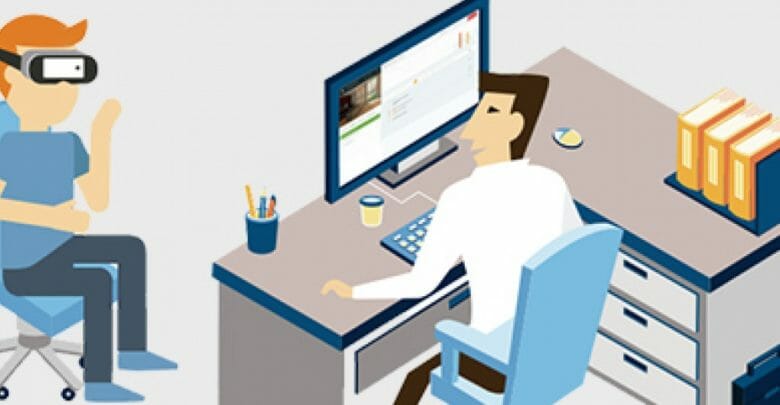In online virtual worlds like Second Life, people are forming new kinds of relationships and living new kinds of lives outside bodies in entirely re-imagined selves

In online virtual worlds like Second Life, people are forming new kinds of relationships and living new kinds of lives outside bodies in entirely re-imagined selves. With one billion people estimated to have a presence in virtual worlds by 2018, isn’t it time the therapy profession started to give the phenomenon some serious attention?
- Imagine working with a client who leads a double life. In one life, they hold down a regular job, have lots of friends, own a home, and are in a committed relationship. They might even have children. But whenever they can – during quiet times at work and late into the night when their partner is sleeping – they live an entirely separate life. In this second life, they have another name, an alternative home, a new set of friends, and a different partner. They live this life in a body they have constructed to their own chosen specification, possibly one of a different gender to their own. Now imagine that this client wants to explore and make sense of both of these lives, both of these different selves, in therapy with you.
- This may sound like a far-fetched scenario, but around the world an increasingly large number of people are leading double lives through the medium of online virtual worlds like Second Life. Research firm Gartner estimates that 80 per cent of Internet users worldwide will be in non-gaming virtual worlds like Second Life by the end of 20111. Another recent study predicts massive growth of up to one billion people by 20182.It consequently stands to reason that we can expect more and more clients to present in therapy with issues related to their virtual as well as their actual lives. Indeed, the huge growth of people living virtual lives – through social networking and Internet dating sites, as well as through virtual worlds, of which Second Life is just one example – is such that the counselling and psychotherapy profession is starting to pay the phenomenon some serious attention. In April, the Psychosynthesis and Education Trust in London held a one-day conference on the subject, and Kym Winter, deputy head of counselling at the University of Hertfordshire, led a session at the BACP Annual Conference in October, considering the implications for how we might practise with the newly emerging technology-savvy generation.What is Second Life?
Launched in 2003 by San Francisco-based virtual world technology company Linden Lab, Second Life is a 3-D virtual world created by its residents, which in March this year numbered 13 million registered users worldwide. Billed as a place ‘dedicated to creativity’, when you first log into Second Life, you construct your own virtual self, or ‘avatar’, to define how others will see you. This avatar will be your own unique incarnation in the virtual world.You can either choose to act out your original self in Second Life or, from a comprehensive menu of options, you can customise hundreds of details to create a whole new self – changing your height, body type, hair, eye colour, and skin tone to suit your ideal self-image. You can even change gender. Indeed, when offered the flexibility to do so, a recent study by researchers at Nottingham Trent University found that 70 per cent of female players and 54 per cent of male players reported doing just that3.Using just a keyboard and mouse, once you’ve created your avatar, you are ready to be born into your virtual life. You can then use the online tutorials to learn to walk, talk, manipulate objects and move around (there are vehicles at your disposal but the best part about Second Life is that you can fly). Having done so, you are ready to discover a vast virtual landscape of digital continents, where you can visit clubs, shopping malls, space stations, and movie theatres, or attend discussions and events on a wide range of activities from sport and entertainment to education and the arts. Through your avatar, as you travel through Second Life, you will meet other avatars and connect with multiple players across the world. Via instant text messaging, you can engage in real-time interaction with other players, and explore and simulate interactions with few real-life consequences.
Online disinhibition
This liberation from real-life consequences can empower players to experiment in all areas of experience in virtual worlds. Many players tend to reveal more, or be more direct, in the virtual world – a phenomenon called ‘online disinhibition’. One such player, Mary, a trainee counsellor, became actively involved in Second Life whilst spending time at home completing the written work for her diploma. ‘During that year, I could spend between one and five hours a day in Second Life,’ she says. ‘I was escaping into Second Life but using it to explore things that have actually transformed into life-changing opportunities for me now.’In a committed relationship with a same-sex partner, Mary specifically engaged with Second Life to explore issues around her sexuality. ‘I was exploring issues that were too frightening or just weren’t possible for me to explore in reality,’ she says. ‘I was aware of feeling adrift, unstable in my emotional life and unfulfilled in my relationship. So I was finding this space where I could really get that thrill that I was missing in my life.’
This thrill involved several virtual flirtations with male avatars, encounters which at that time would have been too threatening for Mary to experience in real life because of her commitment to her relationship and also because of her anxieties about sexual intimacy with men. ‘Allowing myself to indulge in flirtations with men helped me to stay aware of how deeply I felt this need,’ she says. ‘In my relationship, there were issues that I was trying to avoid dealing with, like my sense of disempowerment in relationships with men, and the shame I feel about being embodied and sexual, and so I felt like giving myself time and space to do that.’
During the 16-month period Mary spent in Second Life, she regularly explored the issues that came up for her with her therapist, who had no previous knowledge or experience of virtual worlds. ‘I felt like I had to educate her,’ she says. ‘But because we were looking at the issues that were underlying what was happening in Second Life, we didn’t spend a long time talking about the technicalities of it.’
As significant relationships began to develop for Mary in Second Life, she brought those to therapy and she also explored whether she might be using Second Life in an addictive way, or as an escape. ‘If I had a night on my own I would be up until I couldn’t stay awake any longer. I would sacrifice sleep to stay connected. I would look up and think, how have three hours passed?’
On balance, however, she does not view her use as addictive. ‘Looking in on me from the outside, you might have said I was addicted to it. But I needed Second Life to stay sane, to explore things, to feel a sense of freedom that I didn’t feel in my life.’
Cybersex
This sense of freedom eventually led her into a virtual sexual relationship with a male avatar that helped her transform her real-life situation and sense of self. Like Mary, he was also in a committed relationship that was not meeting all his needs. ‘We started as friends and then very quickly I began talking about how I’d like to be sexual with him but I didn’t feel safe to,’ she says. ‘I had lots of shame issues that I needed to work with first, and he responded in such an empathic and loving way that showed me that he understood completely where I was at.’Mary and her virtual lover conduct their relationship in Second Life by meeting once or twice a week at designated times. ‘It has provided a safe space for us both to explore,’ she says. ‘He needs someone to meet his passionate expression of desire, who’s not going to judge or criticise it. I need someone who can help me let go of my shame. I feel love when I’m with him and carry a sense of him, the energy he brings, into my everyday life.’
Mary did not begin to have cybersex with her virtual lover until after her relationship with her partner had ended, and does not in any way see her online relationship as a betrayal of her actual one. ‘I didn’t feel a need to tell my partner about it because I had my therapist to talk these things through with,’ she says. ‘I felt that this was something I could keep separate. Part of me knew that I was working out whether this was the relationship that I wanted to stay in.’
The power of imagination
Although she acknowledges that some of the days she spent in Second Life were ‘dark and depressing’, looking back at this period, Mary firmly believes in the therapeutic value of the experiences she’s had in this virtual world. This is an opinion shared by integrative psychosynthesis therapist Keith Silvester, who finds himself increasingly working with clients who bring material from their online lives into therapy. Silvester firmly believes in the potential for virtual worlds to engage the imagination in ways that can be positive therapeutically. ‘Second Life is a journey into a sort of utopia,’ he says. ‘It’s one where you can be who you want to be. You can actually live unlived parts of yourself. It allows people to connect together and to use their imagination.’Silvester compares the process of creating an avatar with the concept of subpersonalities, a core component of psychosynthesis theory. ‘In therapy, we might ask people to think of a subpersonality they don’t normally connect to, and to live it out through a drawing or guided fantasy. What the technology of Second Life allows people to do is to actually realise the fantasy in a much more open way. So they can do it anytime, and in fact it encourages the development of unlived alter-egos and subpersonalities.’
John Suler, a psychology professor at Rider University in New Jersey, USA has argued that it’s possible that interacting through an avatar might stimulate the ‘observing ego’ – the ability to look at oneself objectively and rationally – which is critical to many kinds of psychotherapy1. In this way, virtual worlds might help clients deal with fears or addictions and experiment with new behaviours and means of expression. However, not all players will have the ego strength to distinguish between reality and fiction and clients may possibly objectify or distance themselves from their avatar, or create false selves with online profiles, which in some cases might attenuate the effects of the therapy.
Connection or escape?
‘Some people will use virtual reality gaming as a means of escape rather than a means of engagement,’ says Silvester. ‘Every innovation carries a shadow that can be misused.’ So how does he respond to the claims of sceptics who argue that because online communications are mediated through a keyboard and computer screen – stripped of the non-verbal, visual tools we use to relate in the real world – that far from facilitating engagement, new technologies like Second Life actually provide ways to avoid contact?‘The question is, can you create a meaningful intersubjective space virtually?’ he replies. ‘If you think of the telephone, what one person does at one end creates actual affects in the receiver at the other end. So this question about whether it is possible to achieve intimacy in virtual space has been around ever since the telephone was invented. I would say you can. There are other people who say you can’t, and I think it’s a very interesting debate that will probably run for many years.’
On the topic of cybersex, Silvester believes that having an online virtual relationship is not in itself an issue or problem, but that therapists need to explore the meaning of those relationships within the contexts of their clients’ lives. ‘Any therapeutic phenomenon needs to be looked at in terms of the context in which it’s happening,’ he says. ‘I would say the same about a Second Life relationship. I would want to ask questions of this person: why she’s doing it, what she gets from it, whether it’s creating any harm, or whether it’s a distraction from dealing with a real world issue or a way of dealing with one – it might be a very good way of coping.’
An arena for social interaction
For many players Second Life not only provides a way of coping with real world issues but also a vital arena for social interaction. In his book, Second Lives, author and journalist Tim Guest travels to Boston, USA to meet a group of nine men and women with severe cerebral palsy and mental retardation who, through the medium of technology, have found the means to transcend their restricted real-world selves to achieve freedom of movement and expression in Second Life.Twice a week, for an hour at a time, the group gather in the computer room of their residential care home and enter Second Life through the medium of a collectively created avatar. In the real world, their lack of language severely diminishes their interactions, but online, with a care worker acting as their typist and interpreter, they hold real-time conversations, without the anxiety of being misunderstood, or dismissed because of their appearance. Second Life allows them to experience a completely different and liberated existence and gives them the voice they’ve always wanted to have.
And, Guest argues, it’s not just those isolated with physical or mental disabilities that can find therapeutic value in virtual worlds. In a culture in which more people than ever in the west are living alone (in the UK one in three households now have just one member, compared to one in five at the start of the 1970s), Second Life provides an important lifeline for many socially isolated individuals.
To some extent, Guest’s own journey into Second Life was motivated by a desire to feel part of a community. ‘I found myself in my late 20s, living in a flat, having to travel a long way to see people,’ he says, ‘and often I’d be awake at night and think, what do I do now? There was not a local community that I could go to if I was bored or restless. So these places became an outlet for that.’
However, having experienced a communal upbringing – his mother was a follower of the teachings of the Indian guru Bhagwan Shree Rajneesh (Osho) – Guest has an ambivalent attitude towards community and consequently found himself well suited to the quality of contact he could achieve through Second Life. He believes his simultaneous longing for community and fear of the restrictions it can impose, is shared by many: ‘I think many people have an ambivalent relationship with community. Our solution is to become isolated but it doesn’t solve the problem because we need people. We’re always looking for ways to be close to people but also to keep them at a distance at the same time. As someone finding myself quite isolated but craving a community, Second Life was a safe way of finding one because I could stay at one remove.’
The shadow
Guest wrote about his childhood experience as a member of a commune in his first book,My Life in Orange, and was drawn to Second Life partly because of the comparisons he believes exist between cults and virtual worlds. ‘There are definitely parallels,’ he says. ‘Both offer the promise of a new world, where we’re going to be free, where we can reinvent ourselves. On the surface, the ideology is very similar.’But, as with any vision of a utopia, there will inevitably be a shadow. This is certainly true of Second Life, which in the five years since it was established has come to reflect reality in every dimension, complete with cyber crime, cyber bullying and cyber terrorists known as ‘griefers’ – who harass and insult fellow players and construct objects triggered to copy themselves, until the world overflows and the servers crash.
In fact, far from modelling a vision of a new world, Second Life has in many ways developed into a facsimile of our existing one. Players can purchase virtual currency, known as ‘Linden Dollars’, and trade virtual items within Second Life. In November 2006, virtual currency was changing hands inside Second Life to the equivalent of half a million US dollars a day, and the yearly market in virtual property across all virtual worlds was estimated at $1 billion in 20064.
Multinationals including MTV, Coca-Cola, Sun Microsystems, Intel and Warner Brothers have also capitalised on the marketing potential of Second Life to set up a virtual presence there. And it’s not only the commercial sector that has seen the potential of virtual worlds; the Anglican church has set up an ‘i-church’, the Meenakshi Temple in Madurai offers ‘E-pujas’, and various real-world universities have constructed virtual campuses in Second Life.
Online addiction
But there’s a potentially more worrying shadow side of this new technology: for some, the liberation afforded by these second lives can become addictive. Players can end up spending many hours of the day in isolation, with most of their interaction occurring via the Internet. In this way, critics argue, far from facilitating contact, virtual worlds threaten to increase social isolation and undermine relationships.In his book, Guest writes about the compulsive allure of Second Life and the affect it had on his life: ‘I found myself longing for my second life. Half-way through one dinner party, I abandoned the table to sneak moments at my PC. I lounged in my virtual office, chatting with my virtual friends, when I should have been in my real apartment, entertaining my real friends.’
And, as his research led him to discover, at its most extreme, Internet addiction can lead to death. In South Korea, the most Internetconnected nation on earth, players as young as 28 years old have been known to die of cardiac arrest after 50 hours of continuous play inside virtual worlds.
On balance, however, Guest believes that the potential for Second Life to facilitate communication, social involvement, and wellbeing far outweighs its negative side effects, and he draws an interesting parallel between virtual worlds and dreams to explain why he thinks Second Life can be of psychological benefit. ‘Dreams are a place in which the unconscious is at play,’ he says, ‘not bound by the restrictions of the real world. We’re much freer to express different aspects of our personalities in dreams, and I think that’s very true in virtual worlds as well. Here is a collective dream; that is what it is in a certain sense.
This is a collective place in which we are free, like we are in dreams, without most of the restrictions and responsibilities that we have in the real world.’Potential space
As well as being a place of freedom, Second Life is also a place for play. Monica Whitty, who is programme leader for the first MA in cyber psychology in the UK at Nottingham Trent University, applies Winnicott’s theory of potential space to virtual worlds. ‘What Winnicott says is that in potential spaces it’s important to be playful,’ she says, ‘and, drawing from Freud, play has a serious side as well.’Potential space is the term Winnicott used to refer to an intermediate area of experiencing that lies between fantasy and reality – the area of the transitional object, the therapeutic space, and the areas of cultural experience and creativity. It is in such spaces that individuals might have the opportunity to meet neglected ego needs and allow their true selves to emerge5. ‘When people interact and develop relationships online,’ Whitty says, ‘what they’re doing is sometimes being able to tap into their core self, or true self – the sort of self they really value. But because it’s so important to them, it’s something they don’t often disclose to people normally in their everyday interactions.’
Because of this, Whitty believes that Second Life has huge potential as an environment in which therapy might take place. Indeed, various therapeutic organisations and individuals are already practising there.
A Portuguese organisation uses Second Life as a virtual refuge for abused children, inviting them into the game to help them with social and technical skills inside the real world4. Clients of an alcohol rehabilitation centre in Atlanta, USA are offered an after-care option to meet their therapist for follow-up sessions in Second Life1. The centre has been carefully replicated online and the therapist’s face is mimicked on the avatar. Rather than text-chat, audio is used so the therapist’s voice comes from the avatar during sessions.
There’s also group therapy, with many avatars meeting at once.A place for therapy?
‘Potentially it can be a great space to do therapy,’ says Whitty. ‘Research has found that people can be hyper-intimate, hyper-personal online, more than perhaps they are in offline spaces. Some people don’t feel judged so much in their online relationships either.’ However, the safety offered by the anonymity of online relationships also has its flipside, as Whitty explains: ‘Fantasy worlds can sometimes be detrimental for individuals because you can’t live up to the fantasy offline. You can sometimes stray too far into the realms of fantasy and that can be quite dangerous.’An important question for therapists working in virtual worlds to consider is how clients might transfer what they’re learning about themselves in Second Life into other arenas. This includes considering the implications of moving the therapy from a virtual space, which can potentially feel playful and unreal, into a face-to-face interaction. ‘One of the challenges is that people often self-disclose more online than they would face-to-face,’ Whitty says. ‘So moving from counselling in Second Life to face-to-face might be difficult because the person’s then confronted with all the stuff they’ve self-disclosed that they wouldn’t have perhaps been prepared to do so quickly in the face-toface interaction.’
On the question of Internet addiction, Whitty refers to research being done by Mark Griffiths of the International Gambling Research Unit at Nottingham Trent University. ‘What he’s found through years of research,’ she says, ‘is that there are very few people who are addicted to the Internet. Often people who do develop addictions online have got other addictions and this is just another space for them to live out their addictions. So people who are already gamblers get addicted to online gambling, for instance – it’s just another place to do it. I think we overexaggerate the story of the geek who’s sitting there getting deep vein thrombosis. But it is a concern for some individuals.’
Finally, what is Whitty’s opinion on the question of whether Second Life creates healthy relationships or leads to social isolation? ‘Meeting people that you never intend to meet offline can have some huge benefits,’ she says. ‘And so people who are lonely or who don’t have many contacts offline, can get online and develop healthy relationships, and those relationships can be healthy even if they never transfer into face-to-face situations.’
As the technology is still in such early days, much remains to be seen and tested when it comes to virtual worlds and psychotherapy. Combining psychology with the way we communicate with new media is an urgent need for research and understanding, and courses like the new MA at Nottingham Trent University are increasingly being created to address the need.
‘Second Life has so many possibilities but we’ve yet to really develop it and think about how it’s going to suit people’s needs,’ Whitty concludes. ‘How we replicate non-verbal forms of communication like touch online is important. When we develop relationships, a lot relies on non-verbal signals at first – so how do we translate that online?
‘I see a future in which some people are just going to be doing therapy in online spaces, so we need to develop those spaces to fit people’s needs.’
References:
1. Mollman S. Avatars in rehab: getting therapy in virtual worlds.
CNN.www.cnn.com/2008/TECH/07/16/db.secondlifetherapy/index.html
2. Strategy Analytics. Market forecasts for virtual world experiences.
www.strategyanalytics.com/ default.aspx?mod=ReportAbstractViewer&a0=3988
3. McCabe J. Sexual harassment is rife online.
The Guardian.www.guardian.co.uk/lifeandstyle/2008/mar/06/women.games
4. Guest T. Second lives: a journey through virtual worlds. London: Arrow; 2008.
5. Ogden TH. On potential space. The International Journal of Psychoanalysis.
www.pep-web.org/ document.php?id=ijp.066.0129a





